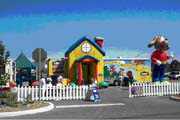In 1998, a national study showed that more children die from preventable household accidents than from any disease. It was a shocking statistic that hit home with the staff at Lowe’s Home Improvement Center.
The nationwide chain, which opened a location on Tonnelle Avenue in North Bergen in April 2002, instituted a program in 1999 to teach grade school children the proper procedures to prevent harmful accidents from taking place in their homes.
The company has created a moveable house called Lowe’s Safety Home that has been displayed at schools across the country. Trained teachers use the house to illustrate how to look out for accidents in the making, in a program entitled the “Great Safety Adventure.”
“It’s designed to create a safer America,” said Mike Crimm, one of the instructors of the tour, which visited several schools in northern New Jersey last week, including North Bergen’s Horace Mann School and Guttenberg’s Anna L. Klein School. “A lot of the times, the kids know a lot of things already, but we go and reiterate what they know.”
Since its inception, the “Great Safety Adventure” has visited more than 300,000 children in more than 2,000 schools nationwide.
According to Crimm, there are four aspects to the safety program, namely learning about fire and burns, falling, choking, and suffocation and poisoning. There are also other accidents that take place in the home, and students are taught how to look for warning signs.
“We taught them about leaving the hair dryer plugged in too long and leaving it plugged in near the bathtub,” Crimm said. “We talked about not leaving their toys on the floor, that they shouldn’t take pills by themselves.”
The 1,200-foot interactive home highlights danger spots, and the students are then asked to point out potential hazards by using a detecting flashlight that would highlight the danger areas.
Crimm said that the program is geared toward students from kindergarten through fourth grades.
“The students are taught that if they see a danger spot, they’re to say, ‘Code Red Rover, Grown-up Come Over,’ ” Crimm said. “That teaches the parent or guardian to come and fix the hazard.”
The young students from Horace Mann School took to the program.
“I learned that you should never take medicine alone,” said seven-year-old Jacob Perez, a first grader. “I also learned that I can’t leave my toys on the top of the stairs. If I did do that, I’ll never do it again.”
“I learned that I can’t leave anything on the floor,” said seven-year-old Israh Mustafa. “I learned that if there’s a fire in the house, you have to get out of the house and not worry about your toys. I learned that if I see matches on the ground, I shouldn’t pick them up.”
Horace Mann first grade teacher Kellie Karameros was very impressed with the program and the way the students listened and participated. “It was very rewarding,” Karameros said. “There was a curriculum guideline to follow, so we knew what to expect. But there were things we all learned. I have a four-year-old at home and I think it helped me personally. There were a few things that I didn’t realize I should do.”
From visiting all the schools and gauging the students’ response, Crimm feels that the program is successful. “Everywhere we go, kids love the program and the kids learn a lot,” Crimm said. “It’s a very beneficial program. Everyone can learn something from it.”
Horace Mann Principal Jorge Prado applauded Lowe’s efforts. “A lot of people don’t fully realize the dangers that are at home,” Prado said. “The interesting thing happens when the kids actually go home and teach their parents, giving them reminders. It’s a worthwhile activity.”
Just how worthwhile? Well, apparently, there were instant results. Just two days after experiencing the “Great Safety Adventure,” Mustafa took the knowledge home.
“This weekend, we had a barbecue at my house,” Mustafa said. “I found matches on the floor and told my mom to pick them up. I learned a lot.”
